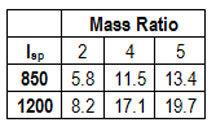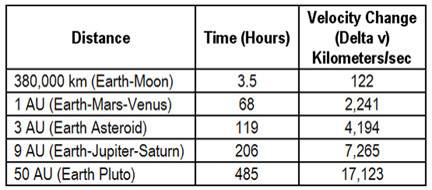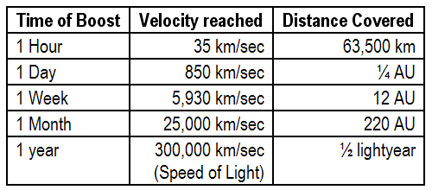A Step Farther Out (27 page)

How would you like to have had a 10 person scientific mission leave Earth orbit in June, 1979, to arrive at Mars 227 days later; orbit Mars for 48 days, then head for Venus; on the way to Venus, encounter the asteroid Eros and stay near it for a day or so; then go on to orbit Venus for 55 days, and finally, 710 days after it departed, return to Earth orbit?
It could have been built. I have a model of the spacecraft that could have carried that mission. It employs a stabilized main section, and a counterbalanced rotating crew-quarters section to give about 10% gravity; it carries plenty of scientific instruments, and a small nuclear electric power plant; and by making rendezvous in Mars orbit with an expendable fuel pod, PILGRIM could have sent down a manned Mars lander.
The model was built by MODEL PRODUCTS of Mount Clemens, Michigan, and sold for about 5 dollars under the name PILGRIM OBSERVER The engineering and celestial mechanics of the model and its mission were very well worked out—and we "really could have built it for a 1979 flight. The engine employed was an atomic rocket called NERVA
Unfortunately, neither the model nor the engine are available any longer, and for the same reason: no public interest. MPC took PILGRIM out of production at about the same time as Congress cancelled the budget of Project NERVA This was just after Apollo 15, when people lost interest in space, and I was involved in trying to save NERVA: involved to the extent of writing some columns in daily papers, and furnishing the House Science Committee with data. But despite my efforts, which weren't important, and those of Congressman Barry Goldwater, Jr., which were very important, NERVA died.
Ironically it died a great success. It had been ground tested and found to work fine.
NERVA works like the "atomic rockets" of the better science fiction writers of the 40's and 50's. Basically, it's a nuclear reactor with a rocket nozzle at the end: you squirt fuel, say hydrogen, through the reactor; it gets hot; and out it comes, fast, to propel the ship.
Now NERVA didn't burn any hotter than the best chemical rockets; in fact, some chemical rockets operate at nearly 3000°, which is better than NERVA's design specs called for. However, V
e
, which is what you want to maximize, depends not only on the temperature of the reaction, but also on the molecular weight of what you're throwing overboard.
Hydrogen burning in oxygen produces water, with molecular weight of 18. Even hydrogen and fluorine give off HF with a weight of 10. (It's also rather corrosive, since the least moisture converts it to hydrofluoric acid.) But NERVA squirted out molecular hydrogen, and that has a weight of only two.
The best tested I
sp
for NERVA was 650. The designers of PILGRIM assumed they'd get 850 by 1978, and that was reasonable. Most engineers now think NERVA-type craft can get I
sp
of 1200. Let's plug
those
into equation three and see what we come up with.
________
TABLE TWO
Delta v from NERVA Ships
(Km/second)

________
Even with the lower figure, you can get a round-trip to Mars at a mass ratio of 4. With that kind of capability, commerce between the planets becomes economically feasible. It's still expensive, but given some kind of system to get materials into orbit at either end, it's more than just possible—it becomes likely.
There's another alternative to NERVA, though, and it too was studied extensively before it was abandoned. It was called ORION, and on first description it seems like the most unlikely method of space travel you ever could devise.
ORION was also known affectionately as Bang-Bang. It worked very simply: you take a
big
ship, and on the bottom you put a very thick metal plate. You hang the rest of the ship in such a way that there are a lot of shock absorbers between the base plate and the ship itself.
Then you set off an atomic bomb underneath the ship.
Believe me, the ship will
move.
When it starts to slow down, you fling another atom bomb down below- and detonate it. You keep doing that until you Ve got enough velocity to get where you want to go.
Silly as it sounds, ORION would have worked. There were some problems. Obviously that base plate and suspension system had to be carefully designed. You probably wanted a small shielded compartment for the crew and those things that couldn't take hard x-rays, and a larger compartment, unshielded, for the rest of the cargo. None of this is all that difficult.
Another problem with ORION was coupling the energy from the bomb to the ship. Atom bombs put out a lot of x-rays and neutrons and heat, and of course once out of the atmosphere there's no blast at all. But even that problem was solved: you have to put something between the bomb and the ship, something that will absorb energy from the bomb and whap! the bottom of the ship to keep it moving: something like Styrofoam, for example, which looks as if it would work despite its unlikeliness.
ORION works better from orbit, but it could lift from Earth—if it weren't for the Treaty of Moscow that prohibits surface detonations of nuclear weapons, and if you weren't worried about the possible fallout.
It has been calculated that ORION would put 5 million pounds in orbit, or land 2 million plus pounds on the Moon—and do it in one whack. That's enough for a fair-sized colony's consumables and machine tools.
Of course we won't use ORION to launch from the Earth's surface, but there's nothing wrong with using it from Earth orbit to plant Lunar and Martian colonies; it's the most efficient and cheapest form of space transportation known, believe it or not.
Moreover, ORION works us toward something even cheaper. The problem with ORION at the moment is that you're blowing off a kilo or so of weapons-grade U-235 with each bang, and that stuffs not cheap.
Aviation Week
and a few other publications have been hinting that fusion bombs with laser trigger are either already or about to be developed: with these, you don't need a U-235 primary,
you
just have a hot laser zap some tritium or deuterium. It's more bang for the buck, and it would power ORION nicely.
Dr. Greg Benford has also described a system that would be even cheaper: you have a big power source on the ship, say a small fission reactor. That feeds a
big
laser. Pellets of tritium or deuterium are ejected below the ship, and zapped from the laser, producing fusion to drive the ship. It's the ORION principle again, carried to its most efficient extreme.
When you've got ships like that, you don't even talk about I
sp
and exhaust velocities, and the mass ratios are actually fractional—that is, the ship that arrives weighs more than the fuel expended to get there.
All these ships were once seriously studied. Now, it's only in universities and among science fiction people that they're mentioned, and even there most don't take ORION-type ships very seriously. Yet any of these ships could have given us the planets—and until either the NERVA or the ORION principles are exploited, the black box boys have won.
Man can dominate near-Earth space using the shuttle and laser-launchers; but until we go beyond chemical rockets, interplanetary space will belong to unmanned probes.
One of science fiction's biggest problems is consistency. Whenever we make an assumption, it's not enough simply to leave it at that; to be fair to the reader, the SF writer should also see what that assumption does to everything else.
This was brought home to me when Jim Baen called to ask for a column on "What happens if we get an
economical
space drive?" The result was not only the column, but the cover story for the issue. ("Tinker," included in HIGH JUSTICE, Pocket Books, 1977).
The problem is more complex than it sounds. In fact, until we have some idea of what
kind
of space drive, there's no real answer at all.
For example: let's suppose we have a magical space drive in which we merely turn on an electric motor and "convert rotary acceleration to linear acceleration." The Dean Drive, remember, was supposed to do just that.
Incidentally? the Dean Drive wasn't suppressed by big corporations, as I've heard some fans speculate. I am personally acquainted with two men who were given large sums by aerospace companies and instructed to buy the drive if they saw any positive results whatever in a demonstration.
After all, if the thing worked just a little bit, it would be worth billions. Think what Boeing could do with an anti-gravity machine! But, alas, no demonstration was ever given, although the prospective purchaser's had letters of credit just waiting to be signed.
However, couldn't we simply assume that it will work and write an article about the resulting space civilization?
No. The discovery of a "Dean Drive" would mean that every fundamental notion we have about physics is dead wrong. It would mean a revolution at least as far reaching as Einstein's modification of Newton. An anti-gravity device like that would have consequences reaching far beyond space drives, just as E = mc
2
affected our lives in ways not very obviously associated with the velocity of light.
This doesn't mean that "Dean Drive" systems are impossible, of course. It does mean that looking at their implications is a bigger job than I want to take on in a 5000 word chapter.
Jim's question was, "What happens if we have something that gives one gravity acceleration over interplanetary distances at reasonable costs per ton delivered?" Part of the question is easy to answer. Now that I've got my Texas Instruments SR-50 (by the way, they've come out with a really marvelous device called the SR-51, and I hate them) I can
run off a
couple of tables to show what we could do with such a system.
The figures in Figure 22 assume you accelerate halfway, turn end for end, and decelerate the other half, so that you arrive with essentially no velocity. The numbers aren't exact, because I haven't accounted for the velocities of the planets in their orbits—but after all, Pluto is moving about 5 kilometers a second, and Mercury about 50, and when you're playing with velocity changes like these, who cares about the measly 45 km/sec difference between the two? For shorter trips the effect is even less important, of course.
__________
TRAVEL TIMES AND DISTANCES AT
ONE GRAVITY ACCELERATION

* AU = Astronomical Unit (Average distance from Earth to Sun) = 150 million kilometer.
__________
HOW FAR CAN WE GO AT ONE GRAVITY?
 _________
_________
The numbers are a bit startling if you're not familiar with them. Twenty
days
to Pluto? They won't surprise old time SF readers, though. A full gravity is a pretty hefty acceleration. If you don't bother with turnovers but just blast away, the results are given in Figure 23, and they're even more indicative of what one gee can do.
Of course, long before you've reached light-speed at the end of a year, you'll have run into relativistic effects. Your ship gets heavier and your acceleration drops off. I don't care how good your drive is, maintaining a full gee for a year is going to take
work.
We're only concerned with the solar system, though, so we can ignore trips longer than a month and avoid relativity altogether.